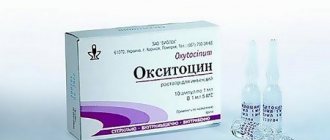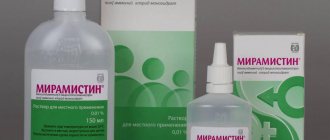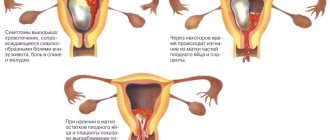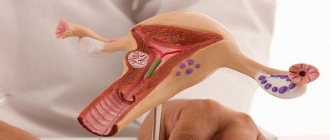Cleaning the uterus after childbirth is a gynecological procedure that can be prescribed by a doctor for diagnostic purposes or for therapeutic purposes (termination of pregnancy, after a miscarriage, to remove a frozen embryo or after childbirth). Cleaning is carried out manually (mechanically) or using vacuum methods. In both cases, local anesthesia or general anesthesia can be used.
Vacuum cleaning is a modern effective method of removing the contents of the uterine cavity to free the mucous layer of the organ from blood clots or remnants (pieces) of the placenta, carried out without damaging the cervix and its walls. There are many indications for this procedure. We will consider those cases when cleaning is prescribed in the postpartum period.
Often, cleaning the uterus after childbirth is a complication associated with the lack of natural release of the placenta and fetal tissue, which cannot be ignored, as it is dangerous for the woman’s health. Many people are afraid of this procedure, but it is not as scary as it might seem. In any case, it’s no worse than childbirth itself (and you’ve already experienced that). In addition, doctors prescribe cleaning only in extreme cases, when it comes to the possibility of more serious complications, the consequences of which can be quite complex, even fatal. Therefore, there is no need to be afraid or refuse the procedure. You just need to figure out what's in front of you.
When to use the vacuum cleaning procedure
Vacuum cleaning is prescribed if the birth of the baby did not end with the spontaneous release of parts of the placenta and blood clots from the woman’s body. This procedure is necessary, as there is a risk of inflammation and the development of infectious pathologies.
There are several indications for such curettage after labor:
- detection of amniotic sac in the birth canal;
- the need for a biopsy;
- the presence of placenta remains in the uterine cavity;
- heavy bleeding.
The procedure is also prescribed in other cases:
- if there is a need for a vacuum abortion in the early stages of pregnancy;
- defective release of fetal remains during spontaneous miscarriage;
- freezing of the fetal development process.
The feasibility of the procedure is determined by the doctor based on data from a gynecological examination, ultrasound, and hormonal tests.
Health care
If a spontaneous miscarriage does not occur, and the timing does not allow us to limit ourselves to medical removal of the frozen embryo from the uterus or to perform vacuum aspiration, an operation is performed - curettage after a frozen pregnancy. The procedure is performed under general anesthesia (if there are no contraindications) in a hospital setting under ultrasound guidance. To avoid serious complications, it is necessary to perform a repeat ultrasound examination 10–14 days after surgery.
Curettage during a frozen pregnancy attempt (cleaning) is by far the most common manipulation in such cases. This is the instrumental removal of a frozen embryo and the mucous layer of the endometrium from the uterine cavity, mechanical surgical cleaning.
When a frozen pregnancy is confirmed, treatment must begin with this procedure. There are also contraindications:
- Acute inflammatory processes of the genital tract.
- Somatic diseases in the acute stage.
- Bacterial and viral infections in the acute stage.
Fetal vacuum extraction technique
VEP is used as an abbreviation. Freezing is one of the indications for prescribing such a procedure for cephalic presentation. The main contraindication is a period not earlier than 36 weeks and a fetal weight of at least 2500 grams.
The device consists of several components, the most important are:
- Plastic cup with attached cable.
- Manual suction.
- Pressure indicator.
- Vacuum release button.
To carry out the manipulation, the woman is positioned on the birthing table with her knees bent and her hips apart. The calyx is inserted into the internal genital tract and applied to the fetal head. By manual suction, negative pressure is created in the cavity of the cup, and then traction (pulling movements) are made with the hands using the cable, aimed at removing the fetus from the uterine cavity and pelvis.
Often you have to refuse to continue the manipulation right in the middle of it. Then they move on to other methods of cleansing the uterine cavity.
Surgical technique
The operation, if curettage during a frozen pregnancy is indicated, is performed in a hospital. When the time for cleaning is appointed, a woman, especially a nulliparous woman, if necessary, undergoes a soft opening of the cervix using kelp sticks in order to injure the cervix less. The day before, she eats a light dinner, before curettage, a cleansing enema is performed, the woman takes a shower and shaved the genital area. The procedure for curettage of the uterus is carried out on an empty stomach.
Everything happens according to the algorithm worked out by gynecologists. The manipulation is performed in the operating room on a gynecological chair using surgical instruments. An anesthesiologist administers anesthesia. External and accessible internal genitalia are treated. The cervix is torn off with special dilators, and the gynecologist surgeon uses a curette (metal loop) to remove the frozen fetus and the inner lining of the uterus.
During cleaning, the woman does not feel pain. Additionally, hemostatic and uterine contracting drugs are administered. The duration of the operation is 15–20 minutes.
- Antibacterial therapy.
- If necessary, hormone therapy or the prescription of hormonal contraceptives for up to 3 months.
- Sexual abstinence for a month until complete healing.
- Mandatory repeat ultrasound after curettage.
You can plan your next pregnancy no earlier than six months after the intervention, unless there are other health problems. During this time, it is necessary to conduct an examination to determine the causes of the fading. After cleaning, the material taken from the uterus is sent for histology, which sometimes helps to find out the cause of the incident.
Cleaning process
Carrying out vacuum cleaning after childbirth is the safest option for scraping out fetal debris and blood clots from the uterine cavity and birth canal. This is due to the fact that such a procedure does not lead to injuries to the cervix or damage to the organ’s mucosa.
Vacuum curettage is used after childbirth, taking into account the following sequence:
- The doctor disinfects the intimate area to eliminate the possibility of pathogenic microorganisms getting on the treated surface.
- A dilator is inserted into the vagina, increasing the diameter of the uterine cervix, which creates optimal conditions for visual examination.
- A manual or mechanical vacuum apparatus is inserted into the organ.
Then a procedure is carried out to clean the uterus from remaining blood clots and pieces of the placenta. Most often, the operation lasts a quarter of an hour.
Scraping is a cleaning aid for the body
It must be said that the well-known expression: “Man is a social animal” is confirmed in all manifestations of human life, starting from the moment of conception and ending with death.
The process of childbirth is no exception: in the wild, the birth of any animal is regulated by the principles of natural selection, and only human children are born under the supervision of medical specialists. It is thanks to the institution of obstetric care that many women maintain their health, the possibility of re-conception, and sometimes even life (not to mention the health and life of their child) - and therefore one should trust the professionalism of people called upon to protect the life and health of their patients. Believe me: without proper reasons, cleaning the uterus after childbirth is not carried out - especially with such a level of medical diagnostics as it is today. The fact is that the integrity of the placenta may be compromised for several reasons: the detachment of the amniotic membranes and placenta from the uterine tissue may be incomplete - particles of the child’s placenta may remain on the walls of the uterus or in its cavity, becoming the cause of many diseases.
Read also: Where does the mother’s umbilical cord, no longer needed by the child, go after childbirth?
First of all, pieces of tissue (or blood clots) lingering in the uterus undergo rotting, becoming an ideal environment for the proliferation of bacteria and viruses - and this can lead to necrosis of surrounding tissues and blood poisoning, not to mention inflammatory processes of varying severity.
In addition, even microscopic particles of the placenta, being in the uterine cavity, are perceived by the body as foreign - and therefore the body strives to get rid of them, expending its (already depleted) protective resources. As a result, the postpartum recovery period is prolonged, which increases the possibility of infection of the reproductive organs, and the woman’s return to the normal rhythm of life is postponed indefinitely.
To avoid such postpartum complications, vacuum or manual (scraping) cleaning is carried out after childbirth.
If we allow ourselves a figurative comparison, then the work of a gynecologist, in this case, can be compared with the services of a cleaning company. Any housewife can maintain order in the house, but sometimes it is difficult to cope alone with eliminating the consequences of particularly stormy parties or visiting too “liberated” guests. Then professionals come to help with cleaning, who will quickly and efficiently restore perfect order and sterile cleanliness: there will be no trace left of food debris, crumbs stuck in the cracks, or dirty shoe prints, which means that the threat of an “invasion” of cockroaches and microorganisms harmful to health will disappear. .
Benefits of the procedure
Vacuum cleaning of the uterine cavity after childbirth has several advantages, due to which it is considered the safest scraping technique. The main advantages of the operation:
- the possibility of early pregnancy termination without damage to the cervix;
- manipulations allow not to damage the walls of the uterus during the operation;
- During the procedure, the woman does not feel pain, as she is given local anesthesia;
- surgery is carried out quickly.
Also, this cleaning technique allows you to reduce the risk of diseases of the reproductive organs, which is why a woman is able to bear and give birth to a healthy baby during her next pregnancy. A minimal amount of mechanical manipulation helps protect the outer part of the genital organs from the formation of cracks.
After childbirth
During the postpartum period, the woman is observed by a gynecologist at the maternity hospital. The doctor assesses the patient’s body temperature, looks at the color and consistency of her discharge, whether the stitches are coming apart, how the mother is feeling and her general condition
It is extremely important to check whether there are any remaining particles of placenta or blood clots in the uterus. If there has been a rupture of the placenta, then the woman must be sent for a control ultrasound
This happens during a caesarean section. And also in the case when the fetal sac grows to the wall and has to be removed manually, helping the natural process.
If tissue remains are detected in the uterus, the doctor may first prescribe the woman to take a drug that will provoke contractions and push out pieces of the placenta along with the discharge. If this method turns out to be ineffective, the woman in labor may be prescribed vacuum cleaning.
If this is neglected, there is a risk of occurrence of foci of inflammation or a purulent process. In parallel, the patient is prescribed antibacterial therapy, and the genitals are regularly treated with an antiseptic.
Breastfeeding is discontinued during this period so that the child’s organs do not suffer from anti-infective drugs. To preserve lactation, milk is expressed and poured out.
Consequences and complications
Despite the fact that the procedure for vacuum cleaning of the uterus is considered the safest after childbirth, it can provoke the appearance of some complications, since due to the removal of the upper layer of the epithelium, the risk of infections, the development of inflammation, and bleeding increases.
Among the main consequences of the operation are:
- the appearance of bleeding, which can provoke the development of anemia;
- menstrual irregularities;
- inflammatory diseases after infection attaches to the wound surface;
- formation of adhesions and scar tissue;
- fusion of uterine tissues;
- development of isthmic-cervical insufficiency due to damage to the cervix;
- loss of ability to bear a subsequent pregnancy;
- infertility.
The onset of pathology after childbirth can be recognized by the appearance of the following symptoms:
- increase in body temperature to 39.9 degrees;
- the appearance of vaginal discharge that has a yellowish, greenish color and an unpleasant odor;
- the presence of severe bleeding, in which the woman must change the postpartum pad every 2–3 hours;
- absence of any discharge on days 2–3 after surgery;
- the appearance of severe pain in the lower abdomen;
- presence of dizziness, chills.
If these symptoms or complications appear, a woman needs to urgently consult a gynecologist.
Vacuum cleaning at home
They practice the use of dry and wet cleaning. Wet is done when applying an additional mask or cream. The entire procedure for vacuum facial cleansing at home is done step by step. It is possible to do cosmetic procedures at home if you follow the instructions.
Before using the device, it is necessary to test the intensity on the forearm, since the tissues there are more stretched. In this way, you can adjust the strength of the vacuum so as not to cause hematomas and other consequences. To tear the head away from the skin, you need to remove your finger from the hole, which is located on the side, so the force of impact will decrease.
Start cleaning from the frontal part, then work on the chin. The device is passed along the chin parallel to the jaw line. In one area they work with the device 3-6 times. It all depends on the condition of the skin. To prevent the formation of hematomas, use the technique from the lower lip to the chin.
The cheeks follow lines from the center of the face to the ears. In problem areas, use a nozzle with a minimum diameter. The wings of the nose are treated with circular movements without interruption.
Important! After completing the procedure, you should not touch your face with your hands.
Devices for vacuum cleaning at home
The effectiveness of the procedure depends on the device for vacuum facial cleansing. For this they most often use:
- Gezatone vacuum facial cleanser (the kit includes a massager and a cleaner with 3 nozzles, which is applicable for peeling, dermal massage, and pore cleaning);
- Panasonic EH 2511 and EH2513 devices (a powerful device that works dry and clean); Power Perfect MC0084 device.
All equipment runs on batteries and is small in size, which easily fits into a travel bag when moving.
How to choose a device?
Before choosing a device for home use, you need to consult a professional cosmetologist who will tell you which one is best suited for a particular skin type. You should not make a decision on your own, as vacuum cleaning with the wrong tool can cause harm. In addition, you need to pay attention to some features:
- the weight and size of the equipment should be such that it is comfortable to hold and does not tire your hand;
- the higher the power, the better the procedure, but it is also desirable that the device has several different speeds.
When purchasing a vacuum cleaning tool, you need to pay attention to the certificates.
How to carry out the procedure?
Before cleansing the skin with vacuum facial cleansing at home, you need to get rid of sebum and decorative cosmetics. Gels and tonics are used for this. Next, the skin is steamed. If the client suffers from pulmonary diseases, then the pores are opened using a special cream.
This is done using a herbal decoction:
- for oily types, a decoction of chamomile or horsetail is suitable, which reduces irritation and improves microcirculation;
- for the normal type, brew calendula, thyme, linden flowers;
- For aging skin, a decoction of clover and birch leaves is suitable.
The face is tilted over the container with the broth and covered with a towel for several minutes. If sweat appears, wipe it off with a paper napkin. Then the purification stage occurs. A special device is moved along the massage lines and along the edges of the face. You can direct the movement of the device in the décolleté and neck area. The procedure is performed within 10 minutes. After the first reading, if there is severe contamination, a repeat procedure may be required, which is carried out 1 month later.
Cleansing is completed by applying a mask that tightens the pores. You can also use an ice cube or frozen herb, which is moved along the massage lines. At the end, apply moisturizer.
Interesting! After vacuum cleaning, do not use decorative cosmetics for 2-3 days.
We suggest you look at all the features of the procedure:
Vacuum cleaning during frozen pregnancy
Vacuum cleaning of the uterus is carried out not only after childbirth, but also during frozen pregnancy.
Curettage of a fetus that has stopped developing is carried out in the case when the woman’s body does not independently reject it. In this case, the vacuum cleaning method for frozen pregnancy is used according to similar instructions.
After the procedure for eliminating fetal remains, an analysis is carried out for histology and the presence of genetic disorders. This is necessary to diagnose the causes of pregnancy loss.
After the operation, the woman must be observed by the attending physician. If alarming symptoms appear, you should consult a doctor to eliminate the possibility of developing pathologies that threaten life and health. Normally, during the postoperative period, pain in the lower abdomen and weakness may be felt. It is also possible for a bloody discharge to appear, which continues for 6–9 days after cleansing.
Indications
The hardware technique is required for patients who:
- there is excessive activity of the sebaceous glands;
- there are black spots and open ulcers;
- age-related changes have appeared (wrinkles, uneven skin structure);
- there are minor defects;
- there are enlarged pores, dry acne;
- the skin is characterized by decreased turgor.
For very oily skin, manual cleansing methods are not recommended. Vacuum cleaning often precedes the use of other techniques. In this case, the removal of impurities is accompanied by lymphatic drainage and toning.
In the price list, most beauty salons and medical centers offer a service for cleansing the skin using a vacuum. This procedure is often included in a general regimen prescribed to remove fatty plugs or keratinized particles in hard-to-reach places. After the procedure, the skin becomes elastic and youthful. Thanks to the procedure, metabolism is activated and cells are renewed.
Menstrual cycle after cleansing
After cleaning with a vacuum, the menstrual cycle is restored within 30–40 days.
If the operation is performed after labor, menstruation will return to normal only after the end of the lactation period.
In the first 6–9 days after surgery, a woman experiences bleeding similar to menstruation, occurring due to tissue damage in the uterine cavity. If the discharge after cleaning with a vacuum ends abruptly or the rehabilitation period passes without any discharge at all, you need to urgently consult a doctor, as this is a symptom of the formation of blood clots in the organ. Normally, the bleeding should be replaced by a brown spot.
Types of uterine fibroids depending on the clinical course
Depending on the clinical picture of the disease, patients with uterine fibroids are conventionally divided into 2 groups:
- Women with an asymptomatic course of the disease (simple fibroids);
- Patients with fast-growing (or proliferating) fibroids.
Since fibroids usually begin asymptomatically, they can be detected accidentally during an ultrasound examination of the pelvic organs.
It is important to know
With this type of uterine fibroid, gynecological curettage is contraindicated. It is uninformative and is a meaningless operation. The resulting scraping from the uterine cavity “will not shed light on this disease,” but can reveal concomitant pathology.
Fast growing uterine fibroids
This is an active type of tumor. Progresses very quickly, gives pronounced clinical symptoms:
- Pain. Appears when the fibroid leg is twisted or necrosis occurs and nutrition in the node is disrupted;
- Uterine bleeding or irregular spotting. Pathological bleeding is the most characteristic sign of fibroids;
- Dysfunction of neighboring organs. Occurs if the uterus with nodes reaches a large size;
- Severe iron deficiency anemia – is a consequence of intense bleeding;
- Impaired fertility and infertility. Myoma can create an obstacle to the movement of the egg through the tube and interfere with the implantation of the fertilized egg, causing miscarriages and premature birth.
With rapidly growing uterine fibroids, pathological bleeding is often observed.
Such fibroids not only do not decrease during menopause, but, on the contrary, may even increase. Its growth often accelerates during pregnancy.
You can read about how quickly fibroids can grow and how to stop their growth
Is preparation necessary for surgery?
Curettage of the uterus is, of course, an operation, albeit a minor one. Therefore, it is necessary to undergo a medical examination for its successful completion. What tests need to be taken?
- Clinical and biochemical blood tests;
- Blood coagulation studies;
- Blood for HIV infection, syphilis and hepatitis;
- General urine analysis;
- Vaginal smear for pathogenic microflora and sexually transmitted infections;
- Electrocardiogram;
- Ultrasound of the pelvic organs.
Before surgery, it is necessary to pass all general clinical tests.
Before the procedure, a therapist must be examined to identify somatic pathologies and contraindications for anesthesia. The day before the operation, the woman is examined by an anesthesiologist.
On the eve of the procedure, the following conditions must be met:
- Sexual abstinence;
- Do not use douching, vaginal suppositories or tablets;
- Carry out intimate hygiene only with running water;
- Be sure to shave the hair from the external genitalia;
- Cleanse the intestines;
- Take a shower;
- In the evening - light dinner.
On the day of surgery, do not drink or eat. Bring a clean shirt, slippers and a supply of sanitary pads. Before starting the procedure, empty your bladder.











